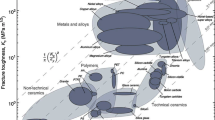Conclusions
-
1.
The strength of metals and alloys after cyclic straining does not vary consistently. Commercially pure aluminum, and copper in part, at first hardened somewhat whereupon they softened again with further cycling. Annealed duralumin and brass showed gains of strength with increasing number of cycles. Cold-worked bronze softened during cyclic stressing.
-
2.
The strength of alloys cyclically strained at their recovery temperatures varies in the same manner as in commercially pure metals.
-
3.
Certain irreversible processes of deterioration (“loosening”) on the slip planes affect the strength changes of metals with increasing number of cycles in alternating plastic bending. The deterioration process can be retarded by initial work-hardening only at temperatures at which recovery, and especially recrystallization, are not operating.
-
4.
Crystal structure defects which develop at a certain stage of cyclic straining cannot be removed by annealing. This is the main difference between the effects of multiple and single plastic deformation on an alloy.
Similar content being viewed by others
Rights and permissions
About this article
Cite this article
Parfenov, V.A. Changes in strength and structure of metals under cyclic stress. Met Sci Heat Treat 3, 164–166 (1961). https://doi.org/10.1007/BF00810569
Issue Date:
DOI: https://doi.org/10.1007/BF00810569



